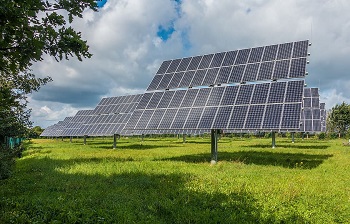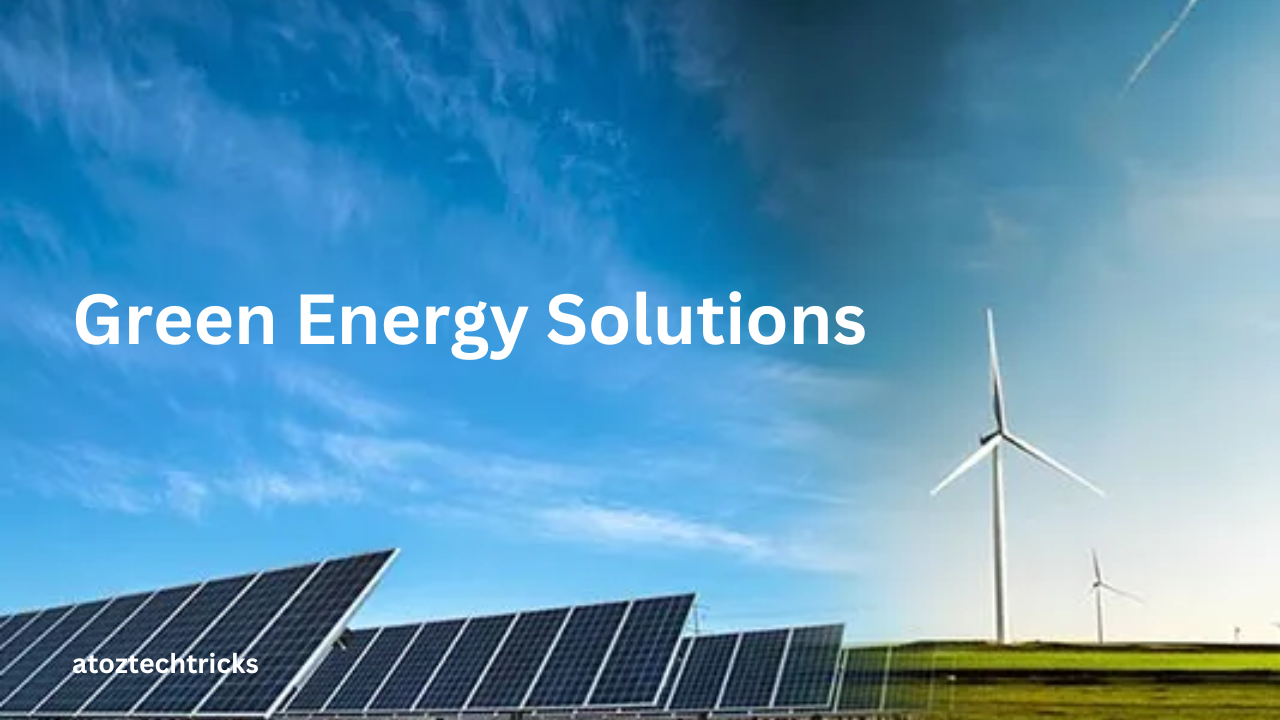Green Energy Solutions: Paving the Way for a Sustainable Future
The increasing urgency to combat climate change, reduce greenhouse gas emissions, and transition to a more sustainable future has placed green energy solutions at the forefront of global discussions. Governments, businesses, and individuals are becoming more aware of the need to shift from traditional fossil fuels to renewable energy sources. Green energy solutions offer a path to a cleaner, more resilient energy system that addresses environmental concerns and provides economic and social benefits. This article explores various green energy solutions, their impact on the environment, and their role in shaping a sustainable future.
Understanding Green Energy
Green energy, also known as renewable energy, refers to energy derived from natural sources that are replenished constantly. Unlike fossil fuels such as coal, oil, and natural gas, which take millions of years to form and release harmful emissions when burned, green energy sources are sustainable and produce little to no pollution. The most common types of green energy include solar, wind, hydroelectric, geothermal, and biomass.
Sustainable Fashion and Accessories: A Guide to Conscious Consumerism
Solar Energy
Solar energy is harnessed from the sun’s rays and converted into electricity or heat. It is one of the most abundant and widely recognized forms of renewable energy. Solar panels made up of photovoltaic (PV) cells, capture sunlight and convert it into electricity. There are two primary types of solar energy technologies: photovoltaic solar power and concentrated solar power (CSP).
- Photovoltaic Solar Power: PV solar power is the most common form of solar energy generation. PV cells convert sunlight directly into electricity through the photovoltaic effect. This technology is used in various applications, from small-scale residential rooftop installations to large utility-scale solar farms.
- Concentrated Solar Power: CSP systems use mirrors or lenses to concentrate a large area of sunlight onto a small area. The concentrated light is then used as heat to generate electricity. CSP is typically used in large-scale power plants and is more efficient in areas with high direct sunlight.
Impact of Solar Energy: Solar energy is a key player in the fight against climate change. It reduces dependence on fossil fuels, lowers greenhouse gas emissions, and provides a sustainable energy source. The rapid decline in the cost of solar panels and advancements in technology have made solar energy more accessible to both individuals and businesses.

Wind Energy
Wind energy harnesses the power of wind to generate electricity. Wind turbines, which consist of large blades mounted on a tower, capture the kinetic energy of the wind and convert it into mechanical energy. This mechanical energy is then transformed into electrical energy through a generator.
- Onshore Wind Farms: Onshore wind farms are located on land and are the most common type of wind energy installation. These wind farms are often found in rural areas or open spaces where wind speeds are consistently high.
- Offshore Wind Farms: Offshore wind farms are situated in bodies of water, typically in the ocean or large lakes. Offshore wind farms benefit from stronger and more consistent winds compared to onshore farms, leading to higher energy production. However, they are more expensive to install and maintain.
Impact of Wind Energy: Wind energy is one of the fastest-growing sources of green energy worldwide. It provides a clean, renewable source of power that reduces reliance on fossil fuels and decreases carbon emissions. Wind energy also creates jobs and stimulates economic growth in the regions where wind farms are established.
Hydroelectric Energy
Hydroelectric energy, or hydropower, generates electricity by harnessing the energy of moving water. This is typically done by using dams or water turbines to capture the kinetic energy of flowing water and convert it into electrical energy. Hydropower is one of the oldest and most established forms of renewable energy.
- Large Hydropower Plants: These plants typically involve the construction of dams on large rivers. The water stored in a reservoir behind the dam is released to flow through turbines, generating electricity.
- Small and Micro Hydropower Systems: Small-scale hydropower systems generate electricity on a smaller scale, often for individual communities or small industrial operations. Micro-hydro systems are even smaller and are designed to power single homes or small businesses.
Impact of Hydroelectric Energy: Hydropower is a reliable and efficient source of renewable energy, providing a steady supply of electricity with low operational costs. However, large-scale hydropower projects can have significant environmental and social impacts, including the displacement of communities and disruption of ecosystems.
Geothermal Energy
Geothermal energy is derived from the heat stored within the Earth’s crust. This heat can be used to generate electricity or provide direct heating for residential, industrial, and agricultural applications. Geothermal energy is available year-round and is not dependent on weather conditions, making it a reliable source of renewable energy.
- Geothermal Power Plants: These plants extract heat from deep within the Earth and use it to generate electricity. The most common types of geothermal power plants include dry steam, flash steam, and binary cycle plants.
- Direct Use Applications: Geothermal energy can also be used directly for heating buildings, greenhouses, and industrial processes. This is done by tapping into hot water or steam reservoirs near the Earth’s surface.
Impact of Geothermal Energy: Geothermal energy is a highly efficient and sustainable energy source with a low carbon footprint. It provides a stable and reliable supply of energy, particularly in regions with abundant geothermal resources. However, the development of geothermal energy is location-specific, and its potential is limited to areas with suitable geological conditions.
Biomass Energy
Biomass energy is produced from organic materials such as wood, agricultural residues, and animal waste. These materials can be burned directly to produce heat or converted into biofuels like ethanol and biodiesel. Biomass is considered renewable because the organic materials used can be replenished through natural processes.
- Solid Biomass: This includes wood, agricultural residues, and other organic materials that can be burned directly to produce heat or electricity.
- Liquid Biofuels: Liquid biofuels, such as ethanol and biodiesel, are produced by converting organic materials into a liquid form. These biofuels can be used as a substitute for gasoline or diesel in transportation.
Impact of Biomass Energy: Biomass energy provides a renewable alternative to fossil fuels and helps reduce greenhouse gas emissions. However, the sustainability of biomass energy depends on the source of the biomass and the methods used for its production. Unsustainable practices, such as deforestation for biomass production, can negate the environmental benefits of this energy source.
The Economic and Social Benefits of Green Energy
Green energy solutions offer a range of economic and social benefits in addition to their environmental advantages. These benefits include job creation, energy security, and improved public health.
Job Creation
The transition to green energy has the potential to create millions of jobs worldwide. The renewable energy sector, including solar, wind, and biomass, is labour-intensive and requires a wide range of skills, from manufacturing and installation to maintenance and research and development. According to the International Renewable Energy Agency (IRENA), the renewable energy sector employed over 11 million people globally in 2018, and this number is expected to grow as the demand for green energy increases.
Energy Security
Green energy solutions enhance energy security by reducing dependence on imported fossil fuels. Countries that invest in renewable energy can generate their energy locally, reducing the risks associated with volatile global energy markets and geopolitical tensions. This increased energy independence also makes nations less vulnerable to supply disruptions and price fluctuations.
Improved Public Health
The shift to green energy can lead to significant public health benefits by reducing air and water pollution associated with fossil fuel combustion. Traditional energy sources, such as coal and oil, release harmful pollutants that contribute to respiratory diseases, heart conditions, and other health problems. By transitioning to cleaner energy sources, communities can enjoy improved air quality and a healthier environment.
Economic Growth
Investing in green energy can stimulate economic growth by creating new industries and markets. The development of renewable energy technologies, such as solar panels and wind turbines, requires investment in research and innovation, leading to advancements that can be commercialized globally. This not only boosts economic activity but also positions countries as leaders in the emerging green economy.
Eco-Friendly Product Development: A Sustainable Path to Innovation
Challenges and Barriers to Green Energy Adoption
Despite the numerous benefits of green energy, several challenges and barriers must be overcome to achieve a fully sustainable energy system. These challenges include technological limitations, high initial costs, regulatory hurdles, and the need for infrastructure development.
Technological Limitations
While green energy technologies have made significant advancements, there are still technological challenges that need to be addressed. For example, energy storage remains a critical issue for renewable energy sources like solar and wind, which are intermittent by nature. Developing efficient and cost-effective energy storage solutions is essential for ensuring a reliable supply of renewable energy.
High Initial Costs
The upfront costs of installing renewable energy systems, such as solar panels or wind turbines, can be a barrier for many individuals and businesses. Although the cost of renewable energy has decreased significantly in recent years, the initial investment required can still be prohibitively expensive for some. Financial incentives, such as tax credits and subsidies, can help offset these costs and encourage the adoption of green energy solutions.
Regulatory and Policy Barriers
In many regions, regulatory frameworks and policies have not kept pace with the rapid development of green energy technologies. Outdated regulations, complex permitting processes, and a lack of supportive policies can hinder the growth of the renewable energy sector. To overcome these barriers, governments need to implement policies that promote the adoption of green energy, such as feed-in tariffs, renewable energy mandates, and streamlined permitting processes.
Infrastructure Development
The transition to green energy requires significant infrastructure development, including the expansion of electricity grids, the construction of energy storage facilities, and the integration of renewable energy sources into existing systems. In some cases, this may require upgrading or replacing outdated infrastructure, which can be costly and time-consuming. Collaboration between governments, utilities, and private companies is essential to ensure that the necessary infrastructure is in place to support the growth of green energy.
The Future of Green Energy
The future of green energy is bright, with continued advancements in technology, increased investment, and growing public support for renewable energy. Several trends are shaping the future of green energy, including the rise of decentralized energy systems, the integration of artificial intelligence (AI) and smart technologies, and the increasing role of green hydrogen.
Decentralized Energy Systems
Decentralized energy systems, also known as distributed energy resources (DERs), involve the generation of electricity at or near the point of use, rather than relying on large, centralized power plants. This approach allows for greater flexibility and resilience in the energy system, as it reduces the need for long-distance transmission and makes the energy system less vulnerable to disruptions. Solar panels, small wind turbines, and energy storage systems are all examples of DERs that are becoming more common as part of the transition to green energy.
Integration of AI and Smart Technologies
The integration of AI and smart technologies is revolutionizing the renewable energy sector by optimizing energy production, distribution, and consumption. AI can be used to predict energy demand, manage energy storage, and optimize the performance of renewable energy systems. Smart grids, which use digital technology to monitor and manage the flow of electricity, are also playing a crucial role in ensuring the efficient use of renewable energy.
Green Hydrogen
Green hydrogen, produced using renewable energy sources, is emerging as a key component of the future energy mix. Hydrogen is a versatile energy carrier that can be used for various applications, including electricity generation, transportation, and industrial processes. The production of green hydrogen involves using renewable energy to split water into hydrogen and oxygen through electrolysis. As the cost of renewable energy continues to decline, green hydrogen is expected to become a more viable and widespread energy solution.
Sustainability-Focused Business Ideas: Innovating for a Greener Future
Green energy solutions are essential for addressing the global challenges of climate change, environmental degradation, and energy security. By transitioning to renewable energy sources such as solar, wind, hydroelectric, geothermal, and biomass, we can reduce our dependence on fossil fuels, lower greenhouse gas emissions, and create a more sustainable future. The economic and social benefits of green energy, including job creation, energy security, and improved public health, further underscore the importance of investing in renewable energy technologies.
While there are challenges to overcome, including technological limitations, high initial costs, and regulatory barriers, the future of green energy is promising. Continued advancements in technology, the rise of decentralized energy systems, and the integration of AI and smart technologies are driving the growth of the renewable energy sector. As we move forward, green energy will play a critical role in shaping a cleaner, more resilient, and sustainable world for future generations.




Post Comment